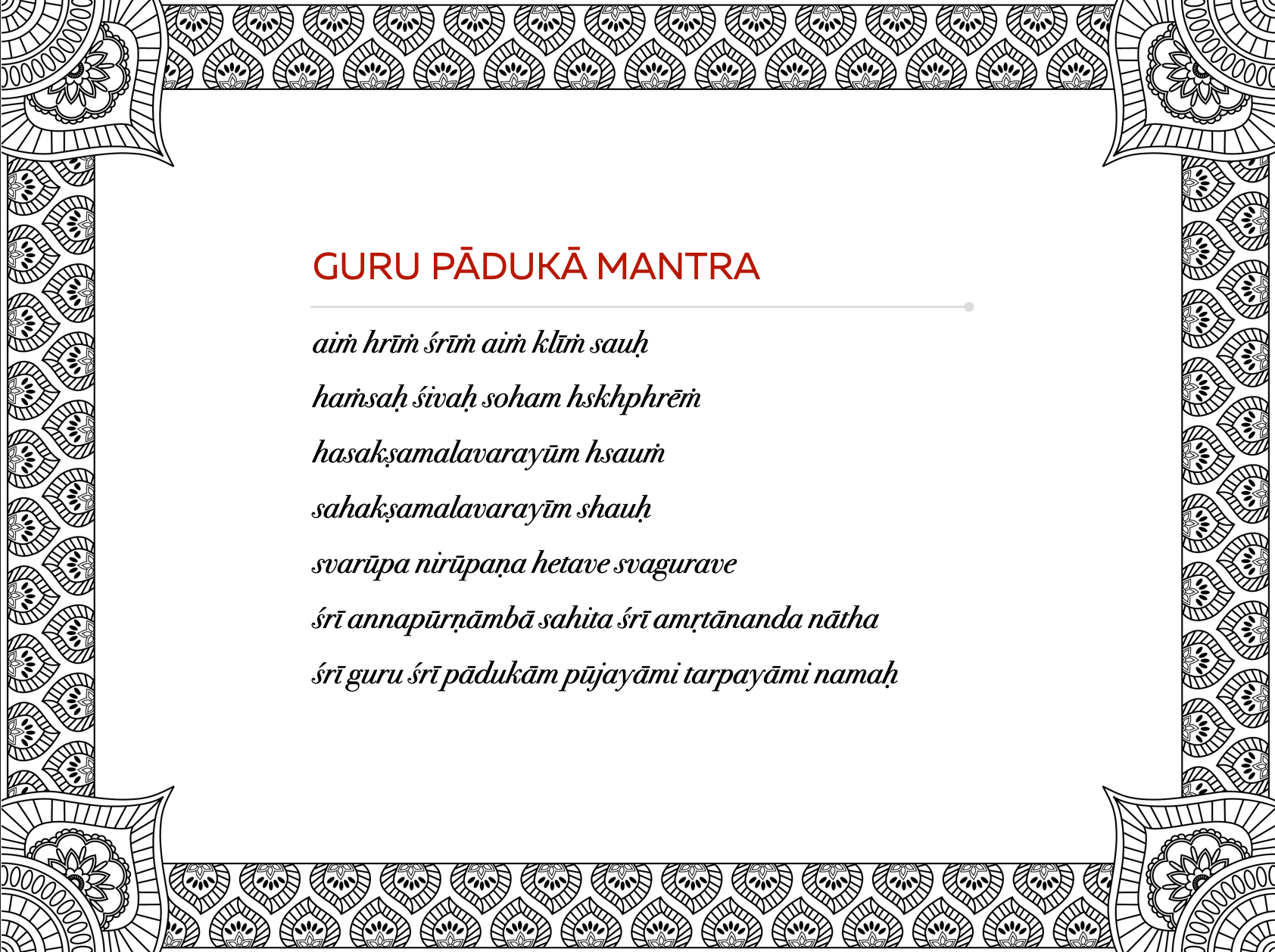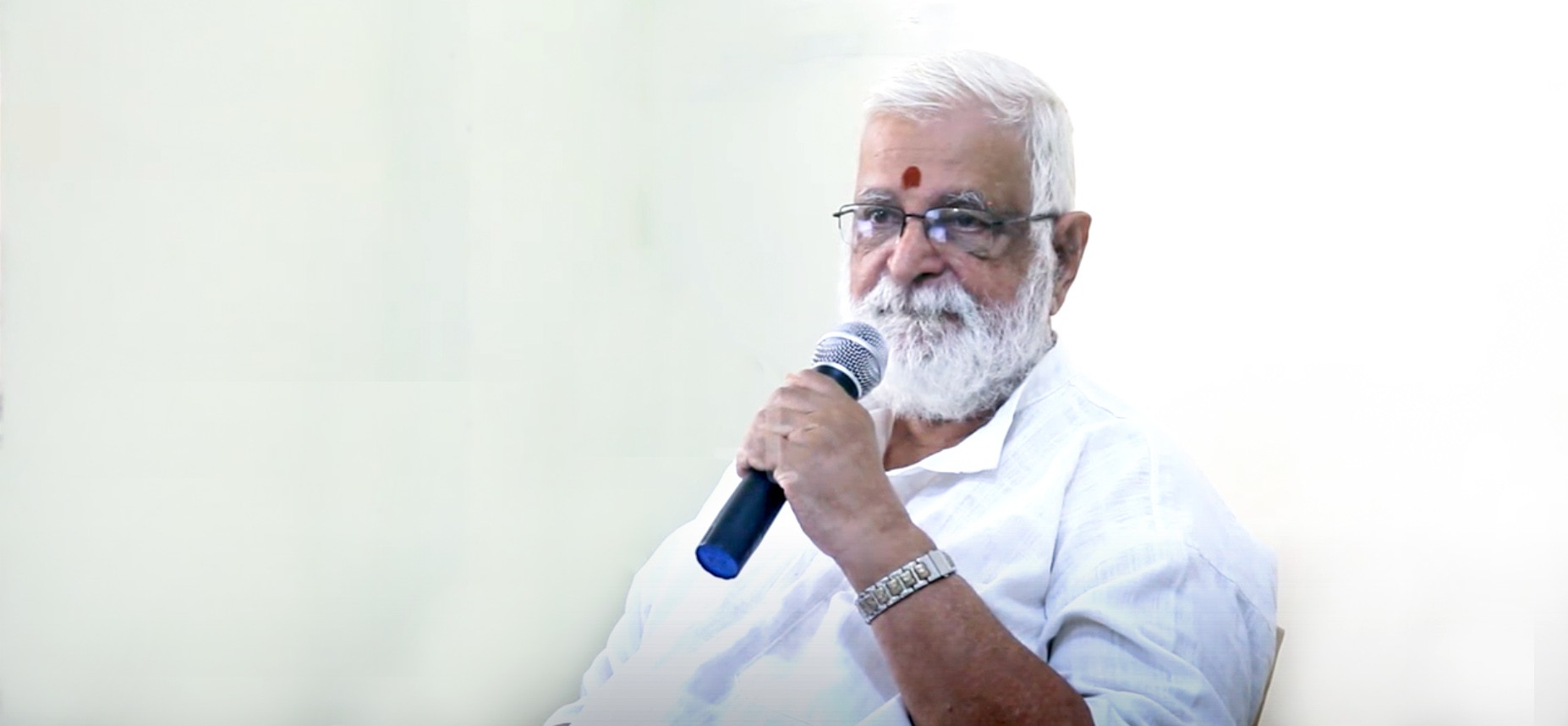- Edited

The Meaning of the Guru Pādukā Mantra by Guruji:
1. Aiṁ Hrīṁ Śrīṁ
Aiṁ is the channel for knowledge. So you are invoking the channel for knowledge for you to understand. For what purpose?
Hrīṁ, the nature of the limitation process, the individual life-giver.
To know the Śrīṁ, to receive the grace of God, so that you can merge back with God from which you came. You are experiencing separateness and limitedness and the pain of separateness and limitations. You want to experience the joy of union. That is the Śrīṁ. You want to gain knowledge to overcome this limitation process and get reabsorbed into the cosmic unity.
So Aiṁ Hrīṁ Śrīṁ is a prayer, which precedes every mantra in the Śrī Cakra Pūjā, which means, Oh Goddess, please give me the knowledge to understand my limitations to overcome them and to experience my truth as You, the Goddess.
2. Aiṁ Klīṁ Sauḥ
Knowledge and the grace of God manifest itself through the process of creation, the process of nourishment and action. In manifesting anything, first, it is an idea in our thoughts. We dwell on it, enhance our knowledge, nourish the knowledge, couple it to material resources, act on it, to make the idea come alive. Then we let go of it. Aiṁ = knowledge, Klīṁ = nourishing and protecting the idea, and Sauḥ = action, fulfillment, and detachment.
3. Haṁsaḥ
Ha - is the sound of the outgoing breath. Saḥ - is the sound of the incoming breath. Haṁsaḥ or So’ham are the mantras of life itself, the breath itself. Every living being breathes and this breathing process is called Haṁsaḥ or So’ham. When you know this it becomes a mantra. It is called Ajapa Gāyatrī. It is one of the forms of the Gāyatrī.
When you concentrate and focus your awareness on the breath Haṁsaḥ then a certain knowledge dawns on you. And it is the knowledge that separates the milk from the water. The legendary bird the Haṁsaḥ is supposed to have the power of separating the milk from the water. That means separating the truth from fiction. The fiction is that I am different from the world. The truth is that I am the world. When you realize that you are the world and that any small thing happening anywhere does not and need not upset you, then this knowledge is what is given by the breath.
The Guru Mantra is telling you that you must focus on your breath, Haṁsaḥ to realize your truth as God.
4. The knowledge that you gain is Śivaḥ So’ham. I am Śiva, the pure unbounded awareness, which is my true nature.
5. Hskhphrēṁ
Ha is the symbol of Śiva. The first breath that a person takes when born is the incoming breath. The last breath is the outgoing breath, which never returns. The first breath is the breath of the mother, and the last breath is the breath of the father. You are merging with the cosmos with the last breath. That is why we say that a person expires when he dies. You are not coming back again into this same body. Ha is the symbol of death, of annihilation, of Śiva. Ha is called visarga in Sanskrit. It means the release of seed, to create life. Ha...aa..aa.. aa is also the symbol of the sound we make during an orgasm when our life juice is going out of ourselves. Then we experience something like a death, a loss of eros, which is lust for life. Our connection to the heaviness of earth reduces, we become light.
Sa is the symbol of Śakti.
Kha is the symbol of space.
Phrēṁ is the movement in space. As Śiva and Śakti, as awareness and its modifications, we move in space. When the realization that I am Śiva dawns on me I forget my body consciousness. I rise above my body consciousness and move freely in space as the union of awareness and its modifications, as Śiva and Śakti. I experience a lightness, a levitating experience which is like flying in space. That in fact is the death experience. Death is an orgasm.
6. To understand the next 2 phrases, Hasakṣamalavarayūṁ hsauṁ ..... Sahakṣamalavarayīṁ shauḥ - we need to know a little bit about what is called the Mātṛka Nyāsa. Mātṛkas - mean the garland of letters of the Sanskrit alphabet. Nyāsa - means placement in the body. In the Mātṛka Nyāsa:
The 16 vowels are placed around the neck,
The 12 consonants Ka to Ṭha around the chest,
10 Ḍa to Pha around waist,
6 Ba to La around the genitals,
4 Va to Sa near the sacrum (cervix),
Ha, Kṣa in the right and left eyes respectively.
All the 50 letters have specific locations in the body. They may be called short addresses to refer to body parts.
The Sanskrit alphabets are located in different petals on the lotuses which are linked to the stem of your spinal cord. Next, you have to understand where Ha is located, where Sa is located, where Kṣa is located, where La is located, Va, Ra, and U are located. When you locate them all, you will discover a path traced by these seed letters.
Hasakṣamalavarayūṁ and Sahakṣamalavarayīṁ are the two paths of light traced by locating where the letters are in your body. The Guru mantra teaches you how to move awareness in specific parts of your body to move Kuṇḍalinī in the Ida and Piṅgala Nādis. This is the Mantra Yoga path to Kuṇḍalinī.
Hsauṁ and Shauḥ, which you see here mean: Hsauṁ is formed by H and Sa and Auṁ. Shauḥ is formed by S and Ha and Auḥ. When Ha is the first letter, it means Śiva nature dominates, the male is in Yoga withholding the seed, not ejaculating it. Śakti, however, needs to draw the seed out of male Śiva to give birth to a new life. That is Her purpose. She is the creatrix, the procreative power located in the vulva. She has to extract the seed and place it in Her womb. When Śakti (Sa) is dominant, the first letter, She does extract the seed, and so Auṁ becomes Auḥ. Ha = visarga = creation. The creativity is the Auṁ. Auṁ is holding the seed within. It is vibrating within as vitality, but it is not being let out. When Śiva in Yogic power is dominant the seed is contained within oneself. When Śakti is dominant, She is asserting Her power to manifest, She extracts the seed orgasmically out of Him and places it in Her womb and proceeds with the creation. So Hsauṁ and Shauḥ are the male and female orgasms, holding the seed and ejaculating the seed. What we discussed so far is the invariant parts of the mantra.
7. Svarūpa Nirūpaṇa Hetave - Svarūpa - your true nature, nirūpaṇa - to prove, hetave - the cause. The cause for proving to yourself your true nature.
8. Svagurave - to your own Guru who has initiated you, who is all-important. You don't have to worry about anyone or anything else.
9. Śrī Annapūrṇāmbā Sahita - is the Śakti, the power behind the Guru
10. Śrī Amṛtānanda Nātha - Mṛtyu means death. "A" is negation. Negation of death is Amṛta. Therefore, amṛta means nectar. Your Self is not born. How can it die? The amṛta, nectar is aja (unborn). Ānanda - means bliss, which is undying, unchanging. The bliss of nectar is Amṛtānanda. Every one of these Gurus according to the Datta Saṁpradāya (lineage) are known as Nāthas. There are nine Nāthas. We follow that saṁpradāya. Nātha - literally means husband/wife, married to you, with whom you have to be intimate for your progress. More importantly, the Guru is committed to taking care of you (just like a husband/wife) as a soul mate.
The real Guru, Goddess/God speaks through the Guru, who can be either female or male. Don't confuse the Guru with a physical form. The Guru of everyone is one and the same. And that is God/Goddess.
Guru appears to different people in different forms, but the form is only a symbol. You have to look behind the symbol to the truth and that truth is called Jagannātha. Jagat - means the world, Nātha - means husband/wife, the husband/wife of the manifested world. The Guru is referred to as the husband/wife here so that you can open up your body, mind, and soul without any inhibitions for deepest truths can be learned without inhibitions.
10. Śrī Guru - is the Guru who is the source of all powers, Śrī who is the wealth of the Lord is the Guru. In the Bhāvanā Upaniṣad, it says, "The Guru confers the wealth of the Lord on you”.
11. Śrī Pādukām - the beneficial, auspicious lotus feet of the Guru, which he has placed on the top of your head. You are not to think of the form of the Guru like this, but as Ardhanārīśvara which is half Śiva, male, and half female, Śakti. In that form, the right half is the male part and the left part is the female part. They are eternally united at all the chakra centers at the mūlādhāra and all the way up. And out of their union, their eternal union flows the bliss as the Gaṅgā flows from the head of Śiva. It overflows and falls down to Śiva's feet where it becomes nectar flowing onto the top of your head. So it is that Guru who you must see.
12. Pūjayāmi - I worship that Guru.
13. Tarpayāmi - That which gives you satisfaction. What makes you say, "Yes, I have had enough, I don't need any more"? Having reached that state is called tarpaṇam. It means you must be able to make the Guru feel totally satisfied, that you have rendered all that you are possible or capable of doing. You have given him the supreme happiness of whatever he desires, that is tarpaṇam. So I worship him (the Guru can be male or female), I adore the feet, I make the Lord and His power totally satisfied.
What is the desire of the God or the Goddess? They are both self-fulfilled. What desires could they have? Although you are saying I am satisfying the Guru, what it really means is that you are satisfying yourself. It is you who are not having a fulfilled state. You are identifying with the Guru. It is you who are trying to reach the state of the Guru, the Lord, and his infinite Power. You are trying to fulfill yourself.
So pūjayāmi means you are worshipping the Guru as your own manifestation outside and satisfying her/him means satisfying yourself.
The meaning of the guru mantra tells you the purpose for which you are doing the pūjā, and what it is you want to understand, and what is the result gained by that (haṁsaḥ śivaḥ so’ham) and what the result is going to do for you hskhphrēṁ. And the path through the different chakras, which you must take the Kuṇḍalinī and your awareness. Then you adore the feet of the Guru who has given you initiation.
Source: "Gifts from the Goddess"



